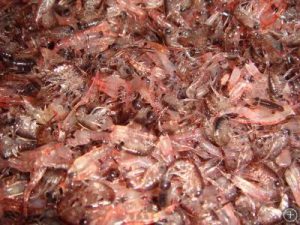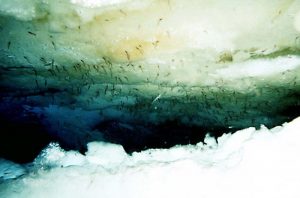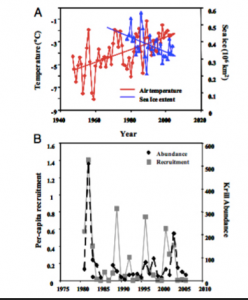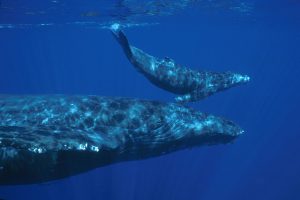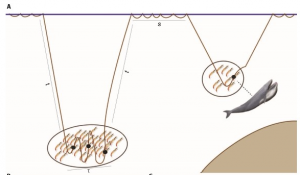The transfer of energy within a food chain: Why do large whales feed on small plankton?
By Meagan Ando, SRC intern
The ten-percent rule toward energy transfer among levels of a trophic system is one that has been used to study ecosystems’ energy dynamics for a long time. But, in order to understand it, one must have a basic understanding of a food chain (Figure 1). Food chains describe the transfer of energy from its source in plants, through herbivores, up to carnivores and onto higher order predators (Sinclair et al. 2003). These different “levels” are known as trophic levels, which is properly defined as the position within the food chain or energy pyramid that an organism can be found. But how much energy is passed along through each level? This is where the ten-percent rule comes in.

Figure 1: An example of a food chain. The first trophic level consists of primary producers gathering energy from the sun, which will be passed up to herbivores, then multiple levels of carnivores (source: nau.edu).
Food webs are often pretty short, which confused many scientists for a long time. Ever wonder why such a large whale feeds on such small planktonic organisms, such as krill? The evidence for the evolutionary advantage of this strategy lies within the definition of the ten-percent rule. When energy is passed along throughout an ecosystem from one trophic level to the next, only 10% of the energy that the first organism receives will actually be passed along. The way in which to study this phenomenon has certainly presented it’s difficulties, as it is clearly impossible to actually visualize the transfer of energy. However, the primary means for determining what marine organisms eat is to study their stomach contents, which is exactly what Reilly et al. 2004 did.
It was known that the International Whaling Commission (IWC) along with the Commission for the Conservation of Antarctic Marine Living Resources (CCAMLR) shared a common curiosity in the idea of the feeding ecology of Baleen whales. This was significantly due to their interests in efforts to place management decisions within an ecosystem context (Reilly et al. 2004). The most efficient way for them to determine their prey sources was to estimate krill consumption by various species of Baleen whales in the Southern Atlantic region during the summer feeding season in the year 2000. In order to successfully draw these estimates, inferences had to be made pertaining to how frequently the whales actually filled their stomachs. This included diurnal change in the forestomach content mass, which ended up producing estimates of 3.2-3.5% of body weight per day (Figure 2) (Reilly et al. 2004). To follow through with the energy tests, four ships participated in the survey to weigh the stomach contents of whales that were unfortunately killed for commercial or research whaling.

Figure 2: Daily consumption rates determined by the four models pertaining to various baleen whales (Humpback, Fin, Right, Sei, and Blue) (Reilly et al. 2004).
In total, 730 cetacean sightings were recorded which included 1,753 separate individuals. It was determined that 83% of the annual energy intake for the whales in this region occurred during this
120-day feeding span in the summer season. The range of total consumption was 4-6% of the standing
krill stock (Reilly et al. 2004). This percentage was derived from the fact that the initial stock included approximately 44 million tons of krill, of which the whales consumed somewhere between 1.6 million and 2.7 million tons (Reilly et al. 2004). These numbers allowed the scientists to make connections between food consumed and the total amount of energy a whale needs to carry out daily bodily functions to survive. It also allowed them to draw conclusions based on where they feed to better protect threatened animals as well as to tweak quotes set for the commercial exploitation of krill, as it is their main food source.
With all of this in mind, it still may not make sense as to why such a large animal would feed on some of the smallest organisms in the ocean. Blue whales, which can be 20-30 meters long, feed on shrimp-like krill that are a mere 2-3 centimeters long. As stated above only ten percent of the energy obtained from one trophic level gets passed along to the next trophic level. For this reason, ecosystems with longer food chains are proven to be, on occasion, less stable than those whose food chains are shorter (Sinclair et al. 2003). Therefore, it is more advantageous for the whale to eat animals on a trophic level in which there is more energy available to be taken in. Hill et al. 2018’s textbook Animal Physiology describes this concept in more depth. In it, they contrast two different possible mechanisms by which a whale can obtain food. One is for the whale to eat fish that are somewhat smaller than themselves. These fish can potentially eat fish that are slightly smaller than themselves, and so on. In this case, there are many trophic levels that the energy will have to pass through before reaching the whale. To apply the ten percent rule directly, we can say that the primary producer produces 10,000 units of energy obtained from the sun. The crustaceans that feed on the producer will generate 1,000 units of energy, from which the small fish that feeds on them will produce only 100 units of energy. The larger fish that feeds on this fish will produce only 1 unit of energy, which may not be enough to sustain the large whale. This is why Baleen whales have evolutionarily evolved into suspension feeders, using Baleen plates to take in large amounts of water and sift through to find small krill. The Baleen whales can eat organisms much smaller than themselves, which can cut down the trophic levels between primary producer and the whale itself, making the energy available to the whale population 1,000 units, as opposed to only 1. In summation, shortening the food chain will in turn increase the food energy available to the whales by a factor of 1,000 (Figure 3) (Hill et al. 2018).

Figure 3: Shorter food chains deplete the energy available to whales less that longer food chains. (Hill et al. 2018).
By better understanding the way in which whales, or any animal for that matter, obtains energy through food, we can further implement new methodologies to better protect them. For example, now that it is known that krill play an extremely important role in the survival of the Blue Whale, agencies can implement new ecological management strategies to be sure that krill populations are not significantly affected by anthropogenic impacts. They may seem like invisible creatures floating in the ocean, but to Baleen whales, they mean a whole lot more.
Works cited
Hill, Richard W., et al. 2018. Animal Physiology. Sinauer Associates/Oxford University Press. Nau.edu. “Life on the Food Chain.” The Food Chain.
Reilly, S., Hedley, S., Borberg, J., Hewitt, R., Thiele, D., Watkins, J. and Naganobu, M., 2004. Biomass and energy transfer to baleen whales in the South Atlantic sector of the Southern Ocean. Deep Sea Research Part II: Topical Studies in Oceanography, 51(12-13): 1397-1409.
Sinclair, Michael, and G. Valdimarsson. 2003. Responsible Fisheries in the Marine Ecosystem. Food and Agriculture Organization of the United Nations 8: 125-131.

